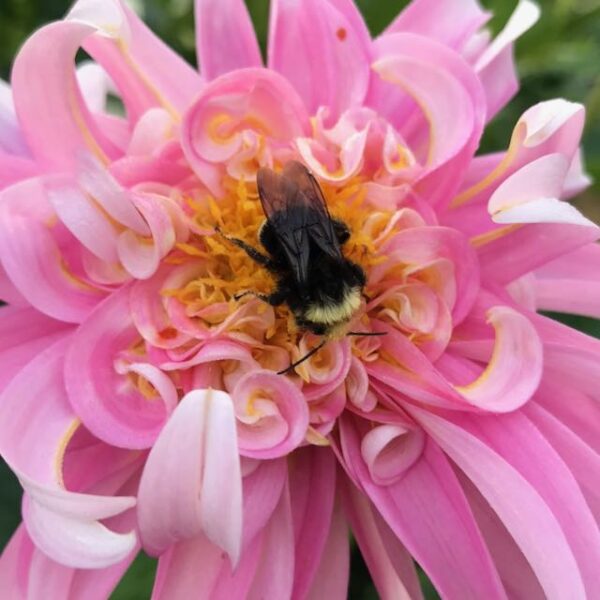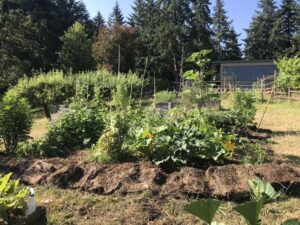Imagine a herd of baby black bears, huggy little creatures more durable than a baby human, but less obnoxious than a puppy, toddling around, crawling, tumbling, busy, innocent, and full of life. That’s what I see when I sit in the garden with my bumble bees. Affection for them swells in me and I want to hug them. I get this way with animals. When I had a livestock farm, I sat in my chicken coop with my birds to become part of the flock and witness how they lived, and I occasionally hugged a chicken just to feel that orb in my hands and imagine all the other orbs stored inside her. I sat with my cows on pasture and listened to them chew, watched how picky they were about what they ate. Sat with my goats and smelled their cheesy breath. Now I sit with bumble bees and set my mind to their wavelength, thinking what I can do to help them grow and thrive just as though I’m farming bumble bees.

My bench is pulled up close to the peppermint and oregano bushes with their stalks of itsy-bitsy blooms, each one holding a micro morsel of yellow goodness waiting for a bee to collect it like they’re doing tequila shots. In my garden the insect pollinators are mostly bees and wasps. But none of them capture my imagination the way bumble bees do with their charming seriousness, their romantic good looks, and their industrious buzz. I’m infatuated with them the way I used to be infatuated with cows. I want my own herd. So, I’m studying up on them, learning their habits and lifecycle and imagining my garden as a bumble bee farm.
Bumble bees are native to North America. They’ve been living on plant nectar here for millions of years and gathering pollen to feed their young. Honey bees are not native but were imported from across the ocean. Research has shown bumble bees are better than honey bees at pollination because they start the season earlier, stay longer in the cold, and their pollen gathering is more thorough. When a couple dozen bumble bees are waddling over a patch of flowers, they resemble a tiny mob of grazing buffalo, and like buffalo they have benefitted the land by co-creating their habitat with the plants they eat.
But when we think of pollinators, we tend to think of honey bees. They’re easier for farmers to manage because they live in large numbers in their hives, whereas bumble bees live in small-group burrows in the ground. Honey bees can be grown like livestock on an industrial scale and shipped on trucks to support commodity crops like almonds and fruit. Bumble bees are place-based and can’t be shipped. And of course, honey bees make volumes of honey enough to supply commercial markets and bumble bees don’t. My dad was once a beekeeper and sold honey at the farmers market. I appreciate the work. But bumble bees are mellower and cuter than honey bees. They’re native bees, so, they’re the bees I care about most.
Three out of four bites of the food we eat require pollination by insects, bats, or birds. If you’re eating a plant-based diet, you might want to think about the future of insects. Apples, peaches and cherries, blueberries, squash and pumpkins, almonds, avocados, coffee, chocolate, sugar cane, tomatoes, tea, raspberries, coconut, and cashews all depend upon pollinators. Alfalfa, a very important food for farm animals, requires bees for pollination. Our agriculture economy, from the smallest farm to the largest, depends on insect pollination to grow our food. Ironically, it’s mostly agriculture chemicals that kill them.
Rachel Carson sounded the alarm on biocides with her book “Silent Spring” in 1962. But change is slow, especially when there’s money to be made by not changing. As Upton Sinclair said, “It is difficult to get a man to understand something when his salary depends upon his not understanding it.” Farmers get into habits, annual routines, just like everybody else, and they resist change, same as the rest of us. Farming with poison has been standard operating procedure all over the world for a century.
But there is hope if we act now. Markets do respond to the power of the purse. Labels like organic, biodynamic, regenerative, non-GMO, free range, and grass-fed are all becoming more popular as we learn to shop our values, and all those methods of farming are better for insects. Your garden, your lawn, your parks, and your open spaces can be pollinator farms. Your neighborhood can be a pollinator corridor. Your kids and their schools can shape a more pollinator friendly future.
Farming bumble bees is a way to bring your attention to the lifecycle of another creature and connect with your local ecology. It’s an activity that engages your senses and enlivens your surrounding with meaningful interaction. Sitting with bumble bees and feeling their energy relieves stress. It’s meditative. The autumnal equinox is near and pollinators are slowing down as the season changes; the nights are cooler, and the sun is sliding away from our hemisphere. I’m going to miss my bumble bees when they disappear for the winter, but I’m already planning next year’s garden with them in mind.
~ : ~
Learn more about bumble bees from Xerces Society



Love your posts! Engaging and informative!
Thanks, Kathy! Glad to know you enjoyed the post.
I so enjoy your writings! Thank you.
I even learned some important information about Bees !
Thanks, Valerie. Great to hear from you.
They are so teddy bear cute, Bumble Bees. Closest I get to appreciating them in my limited garden: Getting a tattoo. Feels like The Friendliest Buzzing Bumble Bee on my skin. Sent this t my sisters, Bil. ml, r